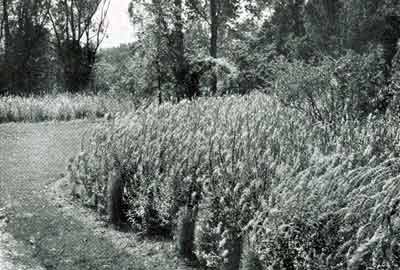Westward Ho! for "Red Sally"
By LEAH STOCK HELMICK
Nature Magazine, September 1937
Twenty years ago, purple loosestrife, Lythrum salicaria, key flower for the great scientist, Charles Darwin, was unknown in Michigan. Roadside flowers were chiefly goldenrods, milkweed and Queen Anne's lace.
Today we see a miracle of Nature, for within those 20 years, loosestrife the same "long purples" of which Ophelia wove fantastic garlands has taken full possession of the countryside. Every marsh and pond-bank of the well-watered region between the great lakes, from Muskegon to Detroit, glows with a mid-summer show of rosy-purple spikes that in places cover thirty or forty acres. The dominant color of the season has changed from yellow to a warm magenta.
This newcomer to the Wolverine State also is comparatively new to America. Less than sixty years ago, Asa Gray described it as still "sparingly wild" in New England, where it first appeared. But its wealth of folknames show its ancient familiarity to the writers and poets of Europe.
Such captions range from the unpleasant "dead man's fingers" and the descriptive "soldiers," "willow-herbs," and "rainbow-weed" to the charming "red Sally," suggested by the coquettish tilt of the rosy-cheeked blooms. A yellow variety quelled angry spirits, so ancients said, and sprigs were tied to ox-yokes to "loose the strife" of unruly animals.
The plant so variously named came to the New World by some unknown carrier and took root particularly well along the Hudson River and in the Wallkill Valley. Botanists say that its present migration is chargeable to birds. The seeds so small that each host might be responsible for a thousand plants are carried in bits of mud stuck to the feet. The species has apparently found another congenial habitat in marshy Michigan.

PURPLE LOOSESTRIFE
Not only has loosestrife added loveliness to the wayside, rivaling the snowy fruit blossoms of spring, but it has proved useful for civic planting and private gardens. It is also a desirable cut flower and, at a recent "Flower Show School," an extension project of Michigan State College, was employed by demonstrators in more than half of their arrangements, the only wildling among fifty cultivated flowers.
The new flower, which Darwin even grew in "clayey soil so dry that a rush cannot be found", may appropriately be seen in greatest beauty at the Arboretum of Hillsdale College, described by the ecologist, Professor Warren Waterman of Northwestern University, as "one of the two finest in the United States." Here, running along the shores of lagoon and bog gardens, loosestrife is a warm central theme for an amphitheatre of bright flowers that scramble up rocky hills in all directions.
A more suitable keynote for such a laboratory could not be found, for loosestrife is the plant that led Darwin to some of his profoundest discoveries.
"I am almost stark, staring mad over Lythrum," he wrote Asa Gray. "I believe it is a grand case of trimorphism! I have tried every one of the eighteen pollinations possible. For the love of Heaven, examine your species and if you can get me some seed, do!"
The slight variations in Lythrum flowers had led earlier botanists to list them as three separate species. Darwin's excitement was due to his idea that the variations in the length of pistils and stamens were complementary arrangements for perfect pollination of one species. There are today only two known examples of such exquisitely adjusted functioning as "trimorphism!"
Darwin proved his theory and made another great discovery that loosestrife depended on insects for its propagation. This was the first absolute proof of this relation between insects and flowers.
"I can lay no claim to being a botanist," he wrote astonishingly in Forms of Flowers. Perhaps not! But his observations and deductions disclosed secrets of Nature never before known to man. He noted that, when reaching for nectar in the base of a loosestrife cup, an insect received a yellow dust on its face, a different pollen on its chest and green pollen on its abdomen. Why?
Eagerly he watched the bee enter a second form of loosestrife, and saw the pollen brushed off upon pistils that were of the same height as the anthers of the previous form. Was this an accident? His tests showed, on the contrary, that the arrangement bore witness to a divine providence. Only crossings at the same levels bore full and fruity seeds! "Illegitimate" fusions within a form or between opposite levels resulted in weak or sterile stock.
Pretty loosestrife, the first known trimorphic flower and the first to betray its dependence on insects, led Darwin through a maze of absorbing and minute experiments and revelations that played a major part in his theory of the Origin of Species. It occupies many chapters of his monumental writings.
But, unmindful of such weighty matters and scientific problems, the cheerful "weed" winds its smiling way through the western world. Wherever birds fly and wet lands lie, "red Sally's" rainbow gleam may be expected.
 Printer-friendly version
Printer-friendly version
